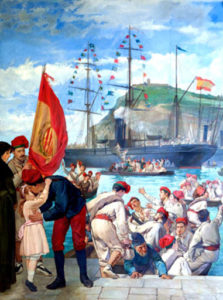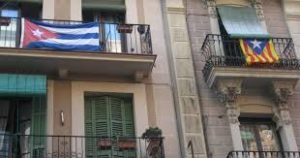THE PRESENCE AND RETURN OF THE CATALANS TO CUBA. PHOTOS
Whenever a town is discussed, the foundation for its character is a concoction of bad jokes, urban legends, and prejudices seasoned with some truth. Of what there is no doubt, because scientific data attest, is that without the presence of the Catalans in Cuba, today our history would be different. And the history of Catalonia would be another, enriched in no small measure thanks to the businesses of its emigrants to the largest of the Antilles.
The Catalans have borne in the history of Cuba an uncomfortable reputation as slave traders, but also as skilled businessmen, stubborn workers, and stingy. If they are cold, they approach a stove but only turn it on when they are about to freeze to death. In short, whenever a town is talked about, the foundation of its character is a concoction of bad jokes, urban legends, and prejudices seasoned with some truth.
Perhaps imbued by his adventurous spirit —or entrepreneurial, which is also what he is called now— a few years ago, the Sabadell Chamber of Commerce, in Barcelona, organized a meeting of Catalan businessmen with government entities in Havana. They weren’t the first to arrive here, naturally. Most of the Spanish firms that currently operate in Cuba (especially in tourism) have a significant share of capital from Catalan companies, banks, private equity, and financial institutions, although their tax address may be in Mallorca, the Basque Country, or Madrid.
THE CATALANS IN CUBA
During the colonial period, and despite their late appearance on the island, the Catalans came to constitute 72% of all peninsulars settled in the colony. They controlled not only the lucrative slave business, but a good part of the manufacture and marketing of Cuban sugar in the international market; tobacco production and the manufacture of some of its most famous vitolas; apart from taking over almost all the retail trade here, were to announce that they were going to the winery, they said: “I’m going to the Catalan on the corner.”
In the early years of the nineteenth century, this migration was going to take root, fundamentally, in the cities of Havana, Matanzas, and Santiago de Cuba (where a considerable number of Catalans settled), although Catalans also settled in other cities on the island. such as Sagua la Grande, Remedios, Cienfuegos, Guantánamo and Camagüey, etc.
As for the city of Havana, 90% of Spanish immigration arrived there and, although the number of Catalans there was not exactly known, it does seem to have been large enough, since in May 1840 a group of them discuss the creation of a charity. Towards the decade of the 70-80s, there were already around eight thousand Catalans in Havana, most of whom were grouped into four associations: the Society for the Benefit of Naturals of Catalonia, the Provincial Humor Society of Catalonia, known popularly known as “Colla de Sant Muc”, the Society of Instruction and Recreation “Catalan Center” and the Commission of the Hermitage of Montserrat. All four would contribute decisively to the maintenance and dissemination of Catalan culture and language.
But the Catalans residing on the Caribbean island went even further, becoming the first in America to publish newspapers in the Catalan language, although they had a very irregular output and a short-lived life. It is worth clarifying that these newspapers were bilingual Spanish-Catalan.
The Estelada is an unofficial flag that Catalan independence supporters often raise to express their support for an independent Catalonia, the flag dates from the early 20th century. It arose from combining the traditional four red stripes on a yellow Senyera field with a blue triangle on the hoist that contains a white five-pointed star, inspired by the Cuban flag. In his designs, the lone star motif signifies Catalan independence. In 1906, the star appeared on Fora Grillons! Magazine’s nameplate. (Breaking chains!), Published in Santiago de Cuba by Catalan exiles, a publication that already clearly proclaimed the independence of Catalonia.
THE RETURN OF THE CATALANS TO CUBA
Given such antecedents, the question then falls due to its weight: will the Catalans return to their business in Cuba? In fact, they have already returned. The reconciliation of the regime with foreign capital, at the beginning of the 90s of the last century, initially had the enthusiasm of investors from that region.
In 2014, Catalan exports to Cuba reached 196 million euros, 10% more than in 2013, although if we follow the statements of some members of the aforementioned delegation of the Sabadell Chamber of Commerce, in a possible future lifting of The North American embargo on the island would project Catalan interests beyond the Cuban market, to the succulent Caribbean, and would turn Catalonia into an ideal logistics base from which they would dedicate themselves to exporting to almost the entire continent, including the North American east coast, the strip with the highest consumption in the world.
The volume of exports from the Autonomous Community of Catalonia to Cuba has grown by 83% in the last decade, between 2006 and 2016, while the number of Calatalas companies that sell products to the Island has also increased by 13%, going from 825 to 929, reports EFE.
Despite the decrease in the Cuban economy, with the fall of the Gross Domestic Product by 0.9% in 2016, in the opinion of the Barcelona Chamber of Commerce, it considers the operation of the Cuban economy favorable due to the change in relations diplomatic courses between Madrid and Havana.
A sample button may be the case of Cecauto, a Catalan company domiciled in Viladecans, province of Barcelona, which for more than ten years has been supplying spare parts to the automotive sector in our market and which (as publicly announced by its own managers) plans Until now, not yet executed in Cuba, to start operating the first private-public transport service on the island, a business bet for which today no one would risk a single kilo here.
In this sense investor, José María Viñals, managing partner of International Operations of Lupicinio International Law Firm, highlighted that the accumulated investment of Spain in the island amounts to 340 million euros, concentrating, above all, in the tobacco, financial, and banking sectors and tourist. However, he emphasized a new window of opportunity for companies: Cuba plans by 2030 that 27% of its electricity production will come from renewable energy sources.
LA PRESENCIA Y EL REGRESO DE LOS CATALANES A CUBA. PHOTOS
Siempre que se habla de un pueblo, el fundamento sobre su carácter es un mejunje de chistes malos, leyendas urbanas y prejuicios sazonados con algo de verdad. De lo que sí no hay dudas, porque lo atestiguan datos científicos, es de que sin la presencia de los catalanes en Cuba, hoy nuestra historia sería otra. Y sería otra la historia de Cataluña, enriquecida en no poca medida gracias a los negocios de sus emigrados a la mayor de las Antillas.
Los catalanes han tenido en la historia de Cuba una incómoda reputación como traficantes de esclavos, pero también como hábiles empresarios, trabajadores testarudos y tacaños. Si tienen frío, se acercan a una estufa pero solo la encienden cuando están a punto de morir congelados. En resumen, siempre que se habla de un pueblo, la base de su carácter es una mezcla de chistes malos, leyendas urbanas y prejuicios sazonados con algo de verdad.
Imbuidos quizá por su espíritu aventurero —o emprendedor, que también así le llaman ahora— hace ya unos pocos años, la Cámara de Comercio de Sabadell, en Barcelona, organizó un encuentro de empresarios catalanes con entidades del Gobierno en La Habana. No eran los primeros en llegar aquí, naturalmente. La mayor parte de firmas españolas que operan actualmente en Cuba (sobre todo en el turismo) cuentan con una importante participación de capital procedente de empresas, bancos, capital privado y financieras catalanas, aunque su domicilio fiscal puede que conste en Mallorca, el País Vasco o Madrid.
LOS CATALANES EN CUBA
Durante la etapa colonial, y a pesar de su tardía aparición en la Isla, los catalanes llegaron a constituir el 72% de todos los peninsulares asentados en la colonia. Controlaban no solo el lucrativo negocio negrero, sino una buena parte de la fabricación y comercialización del azúcar cubano en el mercado internacional; la producción tabacalera y la fabricación de algunas de sus más afamadas vitolas; aparte de copar casi todo el comercio minorista de aquí, donde para anunciar que se iba a la bodega, decían: “Voy al catalán de la esquina”.
En los primeros años del siglo xix esta migración va a radicar, fundamentalmente, a las ciudades de La Habana, Matanzas y Santiago de Cuba (donde se instalaron una cantidad considerable de catalanes), aunque también se instalan catalanes en otras ciudades de la Isla, como Sagua la Grande, Remedios, Cienfuegos, Guantánamo y Camagüey, etc.
En cuanto a la ciudad de La Habana, a ella arribaba el 90 % de la inmigración española y, aunque no se sabe con exactitud el número de catalanes que había, sí parece haber sido lo bastante numeroso, pues en mayo de 1840 se reunió un grupo de ellos para tratar sobre la creación de una sociedad benéfica. Hacia la década de los años 70-80 había ya en La Habana alrededor de ocho mil catalanes, los cuales, en su mayoría, estaban agrupados en cuatro asociaciones: la Sociedad de Beneficiencia de Naturales de Cataluña, La Sociedad Humorística Provincial de Cataluña, conocida popularmente como «Colla de Sant Muc», La Sociedad de Instrucción y Recreo «Centro Catalán» y la Comisión de la Ermita de Montserrat. Las cuatro contribuirían de forma decisiva al mantenimiento y difusión de la cultura y la lengua catalanas.
Pero los catalanes residentes en la isla caribeña fueron todavía más lejos, al convertirse en los primeros que en América publicaron periódicos en lengua catalana, aunque éstos tuvieron una salida muy irregular y una vida efímera. Vale aclarar que estos periódicos eran bilingües español-catalán.
La Estelada es una bandera no oficial que suelen izar los partidarios de la independencia catalana para expresar su apoyo a una Cataluña independiente, la bandera data de principios del siglo XX. Surgió de combinar las tradicionales cuatro franjas rojas sobre un campo amarillo de la Senyera con un triángulo azul en el polipasto que contiene una estrella blanca de cinco puntas, inspirada en la bandera de Cuba. En sus diseños, el motivo de la estrella solitaria significa la independencia catalana. En 1906, apareció la estrella en la placa de identificación de la revista Fora Grillons! (¡Rompiendo cadenas!), Publicado en Santiago de Cuba por exiliados catalanes, una publicación que ya proclamaba claramente la independencia de Cataluña.
EL REGRESO DE LOS CATALANES A CUBA
Dados tales antecedentes, la pregunta entonces se cae por su peso: ¿volverán los catalanes a por lo suyo en Cuba? De hecho, ya volvieron. La reconciliación del régimen con el capital foráneo, a principios de los años 90 del siglo pasado, contó en principio con el entusiasmo de los inversionistas de esa región.
En 2014, las exportaciones catalanas a Cuba alcanzaron los 196 millones de euros, 10% más que en 2013, aunque si nos atenemos a las declaraciones de algunos miembros de la mencionada comitiva de la Cámara de Comercio de Sabadell, en un posible futuro levantamiento del embargo norteamericano a la isla proyectarían los intereses catalanes más allá del mercado cubano, al suculento Caribe, y convertiría a Cataluña en una idónea base logística desde la que se dedicarían a realizar sus exportaciones a casi todo el continente, incluida la costa este norteamericana, la franja con mayor consumo del orbe.
El volumen de exportaciones de la Comunidad Autónoma de Cataluña a Cuba ha crecido un 83% en la última década, entre 2006 y 2016, al tiempo que el número de empresas calatalas que venden productos a la Isla ha aumentado también un 13%, pasando de 825 a 929, informa EFE.
A pesar del decrecimiento de la economía cubana, con la caída del Producto Interno Bruto en un 0,9% en 2016, a juicio de la Cámara de Comercio de Barcelona, considera favorable el funcionamiento de la economía cubana a partir del cambio en las relaciones diplomáticas entre Madrid y La Habana.
Un botón de muestra, puede ser el caso de Cecauto, compañía catalana domiciliada en Viladecans, provincia de Barcelona, que desde hace mas de diez años suministra piezas de recambio al sector automovilístico en nuestro mercado y que (según anunciaran públicamente sus propios directivos) planea, hasta ahora no ejecutado aun en Cuba, comenzar a operar el primer servicio privado de transporte público en la Isla, una apuesta de negocio por la que hoy por hoy nadie arriesgaría aquí ni un kilo prieto.
En este sentido inversionista, José María Viñals, socio director de Operaciones Internacionales de Lupicinio International Law Firm, destacó que la inversión acumulada de España en la isla asciende a 340 millones de euros, concentrándose, sobre todo, en el sector tabaquero, financiero, bancario y turístico. No obstante, hizo hincapié en una nueva ventana de oportunidad para las empresas: Cuba tiene previsto para 2030 que el 27% de su producción eléctrica provenga de fuentes de energía renovables.
Agencies/ DDC/ J. Hugo/ M. Rossi, La Habana/ Extractos/ Excerpts/ Internet Photos/ Arnoldo Varona/ www.TheCubanHistory.com
THE CUBAN HISTORY, HOLLYWOOD.



 THE PRESENCE and Return of the Catalans to Cuba. PHOTOS. * LA PRESENCIA y el Regreso de los Catalanes a Cuba. PHOTOS.
THE PRESENCE and Return of the Catalans to Cuba. PHOTOS. * LA PRESENCIA y el Regreso de los Catalanes a Cuba. PHOTOS.





